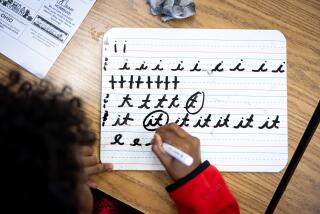OC HIGH / STUDENT NEWS AND VIEWS : Rebuilding Blocks of Education : CAPISTRANO VALLEY : Overall Response Is Good--for Those Who Like to Learn
- Share via
Block scheduling, introduced on an experimental basis this year at Capistrano Valley High School in Mission Viejo, is getting generally favorable reviews from students, teachers and administrators.
It is, as intended, giving students an extended time with fewer subjects on specified days. While students say the new schedule has worked well in many classes, one size does not necessarily fit all. Where it fits or does not fit depends on whom you ask.
“Math classes don’t work because we do two or three lessons a day, and it is hard to grasp the concepts,” junior Adam Weintraub said.
Extra time in English, history and foreign language classes are appreciated, said German-language teacher Beth Gibb. “Students have the opportunity to experience more intense language.”
Junior Carol Hromadka agrees. “Before, just when you got used to speaking in German instead of English, the bell would ring. Now you’re able to stick with it for a while,” she said. Junior Jennifer Fox said she appreciates the extra time to get questions answered.
Electives such as ceramics and choir seem to fare well. Gay Veeh, a sewing and child-development teacher, says that might be because “students are able to accomplish more during the semester.”
Sophomore Anne Chadburn said she doesn’t think there are any classes that don’t work. “It just depends on which classes you don’t like,” she said.
Under the system, students spend 112 minutes, rather than 56 minutes, in classes on a rotating basis. English, for example, is taught in the traditional-length class on Monday, and in an extended period on Tuesday and Thursday, rather than meeting every day of the week.
“The extended-class period maximizes instructional time and allows for student-centered activities,” principal Jessica Gorman said. And, she adds, discipline problems have dropped under the block schedule.
Many teachers are positive about the new schedule. “I have more time to present new lessons because I’m spending less time on attendance and homework checks,” math teacher Marlene Singh said.
Some teachers feel block has created a calmer atmosphere for students, with less stress, less chaos and fewer distractions. Spanish teacher Angie Martin says fewer students are tardy. Many teachers say it is easier to plan for block period because time can be allocated for skits, films, tests and collaborative learning. “Collaborative groups are not frenzied as before,” English teacher Cristina Garrity said.
Even though there seems to be general support for the block schedule, conflict still exists. Some students say that 112 minutes per class is just too long.
“It can be too much to handle for so long,” Hromadka said. “My brain can only absorb so much information in one day. Anything more goes in one ear and out the other.”
But English teacher Garrity argues that this is the environment for true learning. “Our block schedule is a positive stand for learning and thinking in an ‘image-every-instant’ culture.”
The same amount of homework is assigned, but two-days’ worth is given out during one class period. Because the class only meets every other day, students have two days to complete the homework. That, however, can nurture procrastination. “Sometimes I find myself putting everything off until the last minute,” Chadburn said.
*
A separate area of debate centers on how the new schedule affects a student’s non-academic time--particularly for those involved in sports.
Some say the rotating schedule is detrimental to off-season training. Junior Laura Jeffries runs every other day on the block schedule and says the absence of daily practice hurts her preparation for the season.
Gymnastics coach Debbie Cunningham says the block schedule allows time for more thorough workouts. But Bill Harvey, a “walk-on” track-and-field coach (a person who only works as a coach at the school) is against the schedule. “I find that most athletes have a hard time adjusting to the schedule. They have to change the time they eat lunch on certain days because they practice right after lunch.”
Harvey also said he believes injuries have increased because students have less energy and concentration on block days when athletic teams don’t begin practice until 3 p.m. On non-block days, athletes start practice about 1:45 p.m. and finish earlier.
Another point of view: “Less academic time is lost for athletes leaving early for sports competitions,” said principal Gorman.
While the rivalry between teachers and coaches for a student’s time has existed for years, some sports activities actually benefit from the block scheduling. A swimming class, for example, is now offered because of the additional time for students to dry off and change clothes.
Overall, the block schedule has been well received, Gorman said. “Students love it. Parents love it. Teachers love it. Administrators love it.”
The schedule is expected to be continued next year.
More to Read
Sign up for Essential California
The most important California stories and recommendations in your inbox every morning.
You may occasionally receive promotional content from the Los Angeles Times.













